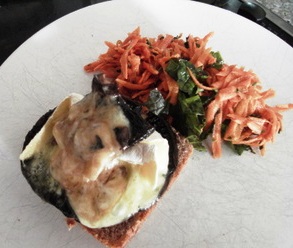Yesterday I received an email from the Guild of Food Writers with sad news: the cookery writer, Katie Stewart, had died.
“…a long-time Guild member and the recipient of our 2008 Lifetime Achievement Award. Katie was taken ill on Friday and died on Saturday” said the email.
My mum gave me The Times Calendar Cookbook (my edition published 1976) and I have used it since the 1980s. I also had the privilege of meeting Katie Stewart when she received her Guild of Food Writers’ Lifetime Achievement Award in 2008.
I tweeted the sad news, and soon there was an outpouring of tweet messages from fellow food writers who, like me, had learnt to cook thanks to Katie Stewart.
I believe generosity of spirit, and the heartfelt desire to communicate and share, really does transmit, to create classic cookbooks.
Yesterday Fiona Beckett, Guardian food writer, suggested on Twitter we have a day/weekend when we cook one of Katie’s recipes. What a great idea. More and more food writers thought so too. (Wow. Social media in action. Love it!).
I suggested we have a #katiestewart hashtag, and explained why at my other blog.
Alex Renton, The Times food writer got in touch. He is doing an obituary piece in Thursday’s edition for Katie, who was The Times cookery columnist.
He did not have a Katie recipe, so I offered to write one down.
I know the page number for pot au chocolate – page 77 – by heart.
My additions in brackets.
Pots de Crème au Chocolat
6oz/175g chocolate chips or plain chocolate broken in pieces
1/2 pint/3 dl. (300 ml single cream)
1 egg
pinch salt
1/2 teaspoon vanilla essence (optional)
Katie says: ‘Put the chocolate in the globlet of a blender. Heat the cream until just under boiling point, then pour on to the chocolate. Cover, switch on and blend until smooth. The heat of the cream will melt the chocolate. Add the egg, salt and vanilla essence and blend again quickly. The mixture at this stage will be quite thin. Pour into six small individual pots, or failing this, small glasses. Chill for several hours or overnight until the mixture is quite firm. Serves 6 ‘
As you will see from my pic, I have played with this recipe over the years, and in 2012, made a raw chocolate version with chilli and orange zest.
Her book, The Times Calendar Cookbook, follows, without fanfare, seasonality: “Fruit, vegetables, meat, fish and game mature according to the seasons and over the year offer us a wide variety of fresh foods to use in recipes,” writes Katie Stewart in her introduction.
The pic of spring vegetables (heading up this blog) is a photograph from the book illustrating May. The vegetables come from Petersham Nurseries, still going strong.
I fear I am jumping the gun a bit because our #katiestewart, or Katie Cook Day as Alex coined it, is really at the weekend.
So please, please all fellow Katie Stewart fans near and far – get cooking at the weekend, share your recipe and…pass it on!
God bless Katie Stewart. What a life-enhancing legacy.
May her soul rest at peace.











![Reblog this post [with Zemanta]](https://i0.wp.com/img.zemanta.com/reblog_b.png)













